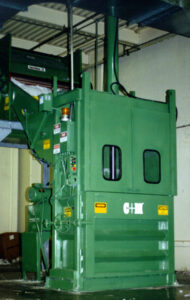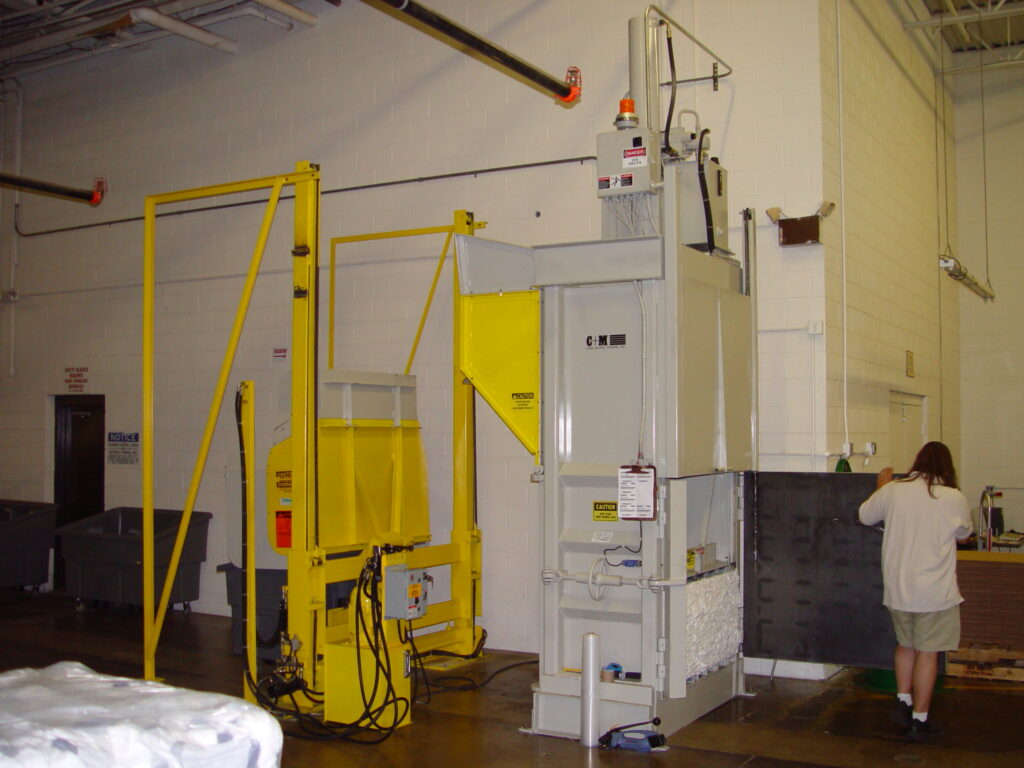Vertical down-stroke balers are the most common style of balers in use due to their relative low cost and versatility. C&M both distributes and manufactures vertical balers. When required for baling low volumes of cardboard, paper, and packaging materials, a vertical down-stroke baler is most often best suited for the job. Various models are available to make different bales sizes, but the most common bale size is 60″ wide by 30″ deep by 48-50″ high. Other models produce bales ranging from 30″ to 48″ wide, 20″ to 42″ deep, and 30″ to 48″ high. Most models have a 6″ bore (diameter) compression cylinder and utilize a 10-HP 230 volt or 460 volt 3-phase hydraulic power unit. A few models are offered with 5-HP power units and can be ordered for use with 220 volt single phase power.
C&M manufactures extra heavy duty and specialty vertical down-packing presses for heavy usage or semi-automatic operation. Some C&M models include a rear loading chute, hydraulic bale eject, high compression force, or custom bale sizes. C&M has, or will custom design, a vertical down-packing baling press for most special applications. Some C&M standard heavy duty models have 20-HP to 40-HP power units and use 8″ or 10″ bore compression cylinders. C&M model CM60HDD-7 produces mill size (and density) bales 60″ x 30″ x 48″ with a 7″-bore compression cylinder and either a 10-HP or 15-HP hydraulic power unit. This model includes a semi-automatic bale eject system with optional features such as a tie-through front door, photo sensor operation, and stationary or hydraulic rear feed chute.

 When deciding if your baling requirement is best suited for a vertical baler or a horizontal baler, the best decision can be made when you carefully and accurately consider both your labor requirements and the volume of waste. For example, loading and baling cardboard can require 30 minutes per 800-1000 lbs bale or 5 hours per 800-1000 lbs bale…depending on the size of the cardboard boxes or sheets. Furniture boxing is large and difficult to fold and load, but office supply or auto-parts packaging is smaller and easy to toss into a vertical baler.
When deciding if your baling requirement is best suited for a vertical baler or a horizontal baler, the best decision can be made when you carefully and accurately consider both your labor requirements and the volume of waste. For example, loading and baling cardboard can require 30 minutes per 800-1000 lbs bale or 5 hours per 800-1000 lbs bale…depending on the size of the cardboard boxes or sheets. Furniture boxing is large and difficult to fold and load, but office supply or auto-parts packaging is smaller and easy to toss into a vertical baler.
As a rule-of-thumb, if your requirements are for one or two bales per day, and the baler does not require a full-time operator to load and operate, then a vertical baler should be considered. But, realize that the labor required to load and operate a vertical baler is much greater than that to simply dispose of boxes into a waste compactor.

And, if large boxes require considerable folding to fit onto a vertical baler or if the waste materials can be loaded more efficiently from overhead or with a belt conveyor, it is possible a horizontal baler will be a lower cost option – even when less than 2 or 3 bales are produced per day. For information on low-cost wide-mouth horizontal balers, see our section on C&M Horizontal Manual Tie balers.
To help confirm your model selection a C&M factory or C&M dealer representative can furnish you with a specification sheet and layout drawing for any C&M Vertical or Down-Packing Baler model or make a recommendation for you.
More than 50% of C&M vertical balers have “C&M custom-designed” features, and C&M offers high quality and low cost standard designed vertical balers for less demanding general uses.








